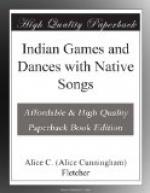An infant was merely a “new life,” it was wholly dependent upon others; no name was given it (only endearing terms were used), for the reason that a name implies either a sacred responsibility or a personal achievement, neither of which was possible to an infant. When, however, the child could go about alone, generally at three or four years of age, the time had arrived when it must be given a tribal name, one belonging to the rites in charge of its birth group. By means of this ceremonial act the child was inducted by sacred rites into the tribe and became a recognized member.
GIVING THE CHILD A NAME
This ceremony, formerly practiced among the Omaha and cognate tribes, took place in the spring, “when the grass was up and the birds were singing.” A tent was set apart and made sacred by the priest who had the hereditary right to perform the ceremony. As the occasion was one of tribal interest, many people flocked to the scene of the rite.
A large stone was brought and placed on the east side of the fire that was burning in the center of the space inside the tent. When everything was ready the old priest stood at the door awaiting the arrival of the child. Then all the mothers who had children of the proper age wended their way to this tent, each one leading her little child, who carried in its hands a new pair of moccasins. As the two reached the tent the mother addressed the priest, saying: “Venerable man, I desire my child to wear moccasins.” (This was a symbolic form of expression.) “I desire my child to walk long upon the earth, to be content with the light of many days. We seek your protection!” The priest made a formal reply and the little one, carrying its moccasins, entered the tent alone. After a few ritualistic phrases the priest accompanied the child to the fire place, where he and the child stood facing the East while the priest sang an invocation to the Four Winds. He bade them to come hither and stand in this place in four groups.
At the close of this Ritual Song the priest lifted the child by the arms so that its little bare feet rested upon the stone, as it faced the South; then he lifted the child again by the arms and its feet rested on the stone, as it faced the West; again the child was lifted and its feet were upon the stone, as it faced the North; once more the priest lifted the child and its feet touched the stone, as it faced the East. Then the priest sang the following Ritual Song:
Turned by the Winds goes the one I send
yonder,
Yonder he goes who is whirled by the Winds,
Goes where the four hills of life and
the Four Winds are standing,
There into the midst of the Winds do I
send him,
Into the midst of the Winds standing there!
This song and the entire ceremony, which is spoken of as “Turning the child,” are highly symbolic and cannot be fully explained at this time. The Winds are the messengers of the great invisible Wakon’da and bring the breath of life and strength to man. At the close of this song the priest put the new moccasins on the feet of the child and sang another Ritual Song which says:




